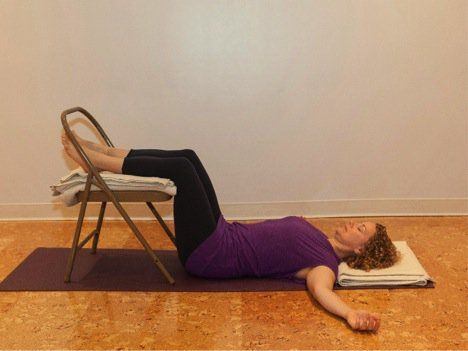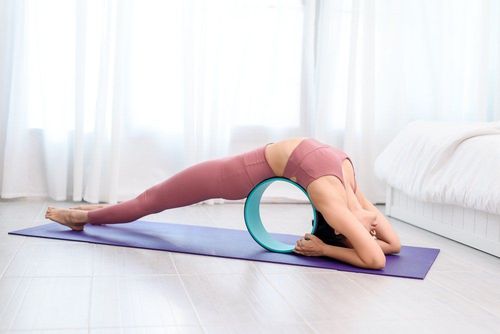This is an automatically translated article.
Prolonged stress is one of the causes of insomnia, fatigue and reduced concentration. Yoga exercises before bed are a natural and effective solution to support the treatment of insomnia.1. How does yoga cure insomnia?
Yoga exercises to sleep well are considered a natural solution to help the body fall asleep that everyone can do at home. Yoga exercises help practitioners relax their body and focus on breathing more. It is this breathing regulation that will help yoga practitioners reduce stress and fall asleep more easily.
According to a survey by the US National Center for Complementary and Integrative Health, more than 55% of yoga practitioners said that practicing yoga helps them sleep better and 85% of people who practice feel less stressed .
During the practice and when completing the poses, the practitioner closes his mouth, inhales deeply and exhales gently through the nose to reduce stress, easier to fall asleep. Practitioners can use support tools such as exercise mats, cushions, blankets, and pillows to create a comfortable posture, hold the posture longer and breathe more regularly.
MORE: Yoga before bed: Benefits and poses to try

. Tập yoga đem lại nhiều lợi ích cho sức khỏe và cải thiện giấc ngủ
2. Yoga poses for easy sleep
7 The following restorative yoga poses will help reduce stress and tension at the end of the day. The more often a practitioner practices these poses, the easier it is to get a good night's sleep.
2.1 Baby pose
Baby Pose with extended knees will help the body rest, adjust the practitioner's mood to be more stable and calm.
How to do it as follows:
The practitioner kneels with both feet on the floor, the buttocks sit on the heels. Next, slowly reach your upper body forward, arms straight, stretch your upper body to the floor, knees hip-width apart, feet straight with knees, straighten feet, gradually bring 2 big toes touching; Gradually separate your knees as wide or as wide as the edge of the mat. Exhale, lower the body to the sides of the thighs, the buttocks touch the heels; Relax your arms along your torso with your palms facing up. This pose helps to release tension in the shoulders by widening the shoulder blades; With an advanced posture, the practitioner can bring their hands forward, relax their hands and palms down on the mat; Relax your facial muscles, chin and neck, gently lower your forehead to the mat, close your eyes, and slowly roll your head to the sides. This pose releases tension in the forehead; Breathe slowly and steadily through your nose, bring your body back to the starting position, open your eyes. When performing the baby pose, practitioners need to be careful if they are injured in the hip and knee.
2.2 Standing upright posture
The upright forward bend position relaxes the neck muscles and gently stretches the calves, thighs, and glutes.
How to do this:
Stand with your feet hip-width apart, inhale deeply; Exhale, extend the torso, bend forward, bring the hands over the legs to lengthen the spine; You can bend your knees slightly so that your chest rests on your thighs; Keep your elbows or hands relaxed, on the floor or on your shins; Inhale - exhale gently; Gently shake the head to relax, loosen the neck muscles; Roll up slowly to bring the body up to avoid dizziness or lightheadedness. If you have a back injury, the practitioner should be careful when performing the standing pose.
2.3 Half bend posture
This is a variation of the standing upright posture, helping the practitioner relax the spinal muscles. The practitioner will therefore relax the body and fall asleep more easily.
How to do this:
Place the exercise mat perpendicular to the wall; Stand in the middle of the mat, feet hip-width apart and parallel to the edges of the mat, arms straight down the body; Inhale, bring your arms straight up to the ceiling, along your ears, open your chest; Exhale, use your waist to bend your body forward; Straighten your back so that your arms and back are parallel to the mat, relax your neck, and keep your chest open. Next, lower your chin to your neck but keep your head slightly down, not much bent; Keeping the position, slowly extend your arms straight to the floor at shoulder height; Bend your knees, use your waist to lift your body, complete the exercise. MORE: Does yoga reduce headaches, is it effective?

Tư thế uốn gập người một nửa
2.4 Fixed angle supine position
This yoga pose helps relieve tension in the hips, knees and genitals. At the same time, the fixed angle supine position also helps the practitioner relax the body and sleep better.
How to do this:
Lie down on the mat, bend your knees, place your feet on the floor, near the tailbone; Touch the soles of your feet together and relax your knees. If the hip muscles are tight, the practitioner can adjust the foot away from the tailbone; Relax your hands on the floor about 45° from your body, palms facing the ceiling, breathing evenly; The practitioner will feel the hips and inner thighs stretch gently but without pain. When performing the fixed angle supine position, the practitioner should be cautious if there is an injury to the hip, knee or genital area. If you feel tired or difficult to do this move, you can place a hard pillow under the knee on each side to support the hip. In addition, the practitioner can roll up a cotton blanket, leaving it along the spine to support the body.
2.5 Normal foot-up position
Pose with feet on the wall is a yoga exercise for insomnia, helping to treat brain circulatory disorders. People who have to stand a lot while working, causing their feet and ankles to swell and become tired, should perform this exercise to relieve pain, relax their legs, and help them sleep more deeply.
How to do this:
Place the exercise mat perpendicular to the wall; Sit down on the mat, bringing the left or right hip close to the wall; Lie on your back on the mat, gently place your feet on the wall, press your knees, squeeze your thighs so that your legs are straight on the wall; Relax the arm at the side of the body; The practitioner can place a pillow under the tailbone to support the spine; Lower your knees, lean over and sit up - complete the exercise.
2.6 Posture on the chair
If it is difficult to straighten the legs on the wall due to back, hip, or knee injuries, the practitioner can perform the pose on the chair. This pose helps to relax the whole body, stabilize the mood during deep breathing.
How to do this:
Put a chair at the end of the yoga mat so that the chair faces the practitioner; Place a folded towel or blanket on the chair. Depending on the height of the chair, you may need to place an extra folded towel under your head; Perform the same movement as putting your feet up on the wall, but here the user bends the knee so that the calf is at a 90° angle to the thigh. If choosing a higher chair, the practitioner needs to roll up so that the calf rests on the chair; Keep your arms relaxed at your sides, palms facing up.

Tư thế gác chân lên ghế
2.7 Corpse Pose
Corpse pose is the final resting pose in yoga exercises. This is also one of the easy sleep yoga exercises that practitioners should practice before going to sleep.
How to do this:
Lie on your back on an exercise mat; Hug your knees toward your chest, squeeze, and breathe deeply; Exhale, stretch your legs, keeping the tailbone on the mat; Feet hip-width apart, relaxed apart toward the edges of the mat. The hip bone touches the floor; The lower back is guaranteed to be soft and relaxed, not feeling pain or tightness; Relax your arms at your sides, palms facing up; Relax your shoulders to avoid hunching. Practitioners should perform yoga exercises to cure insomnia before sleeping and spend about 3-5 minutes for each pose. At the same time, practitioners should note the combination of deep breathing during exercise to sleep easier and better.
Please dial HOTLINE for more information or register for an appointment HERE. Download MyVinmec app to make appointments faster and to manage your bookings easily.
Reference source: health.harvard.edu













